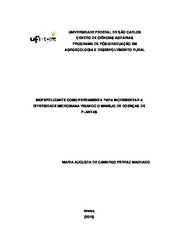| dc.contributor.author | Machado, Maria Augusta de Camargo Ferraz | |
| dc.date.accessioned | 2016-06-02T18:57:31Z | |
| dc.date.available | 2010-08-16 | |
| dc.date.available | 2016-06-02T18:57:31Z | |
| dc.date.issued | 2010-03-04 | |
| dc.identifier.citation | MACHADO, Maria Augusta de Camargo Ferraz. Biofertilizer as tool to increase microbial diversity for management of plants diseases. 2010. 84 f. Dissertação (Mestrado em Ciências Agrárias) - Universidade Federal de São Carlos, Araras, 2010. | por |
| dc.identifier.uri | https://repositorio.ufscar.br/handle/ufscar/88 | |
| dc.description.abstract | In this study were compared the community of yeasts in the phylloplane of lily a conventional system with high pesticide use, with an without pesticide use, with the use of biofertilizers and biocontrol agents; to evaluate the antagonism of yeast Sporidiobolus pararoseus isolated from leaves of lily on Botrytis cinerea; determined the microbial epiphytic in plant lily conventional and without pesticide use systems; characterized microbiological two biofertilizers produced aerobically, one from compost, earthworm-compost, yeast and molasses, and another from swine manure, poultry litter, bone meal and sugar; evaluated the effect of biofertilizers on plant growth-promoting and on the control of pathogens. We observed: the population of bacteria, Bacillus, yeasts and fungi in plants of lily conducted in the conventional system with high pesticide use is low and the population of these organisms is higher in plants cultivated in system without use of pesticides; S. pararoseus is the main component of the microbial community of the lily phyloplane in leaves treated with biofertilizer; S. pararoseus has potential in reducing the incidence and severity of B. cinerea and is essential to maintain a high population to act in the natural of biological control of the disease; biofertilizers as well as organic materials used in production have the potential to control pathogens; swine manure showed higher efficacy in reducing the mycelial growth of Pythium; biofertilizers promoted growth in the plants with the presence of NPK; biofertilizers did not control powdery mildew on zucchini squash, indicating that the effect of biofertilizers on plant diseases depends on the organic material and pathosystem. | eng |
| dc.description.sponsorship | Fundação de Apoio a Pesquisa Agrícola | |
| dc.format | application/pdf | por |
| dc.language | por | por |
| dc.publisher | Universidade Federal de São Carlos | por |
| dc.rights | Acesso Aberto | por |
| dc.subject | Controle biológico | por |
| dc.subject | Biofertilizantes | por |
| dc.subject | Matéria orgânica | por |
| dc.subject | Levedura | por |
| dc.title | Biofertilizante como ferramenta para incrementar a diversidade microbiana visando o manejo de doenças de plantas | por |
| dc.title.alternative | Biofertilizer as tool to increase microbial diversity for management of plants diseases | eng |
| dc.type | Dissertação | por |
| dc.contributor.advisor1 | Bettiol, Wagner | |
| dc.contributor.advisor1Lattes | http://lattes.cnpq.br/4210103622262979 | por |
| dc.description.resumo | O trabalho teve como objetivos isolar leveduras do filoplano de lírio de um sistema convencional, com alto uso de agrotóxicos, com um sem uso de agrotóxicos, com uso de biofertilizante e agentes de biocontrole, avaliar o antagonismo da levedura Sporidiobolus pararoseus, isolada de folhas de lírio produzidas sem agrotóxicos, sobre Botrytis cinerea, determinar a comunidade microbiana epifítica da planta de lírio convencional e sem uso de agrotóxico, quantificar enzimas relacionadas com indução de resistência em plantas de lírios produzidas nesses dois sistemas, caracterizar microbiologicamente dois biofertilizantes produzidos aerobicamente, um a partir de composto orgânico, húmus de minhoca, levedo de cerveja e melaço, e outro partir de esterco de suíno, cama de frango, farelo de osso e açúcar; avaliar o efeito dos biofertilizantes na promoção de crescimento das plantas e no controle de fitopatógenos do solo e de parte aérea. Nos estudos foram observados que: a população de bactérias, Bacillus, leveduras e fungos em plantas de lírio conduzidas no sistema convencional é reduzida e que a população desses organismos é elevada nas plantas conduzidas no sistema sem uso de agrotóxicos; Sporidiobolus pararoseus, principal componente da comunidade microbiana da superfície das folhas de lírio tratadas com biofertilizante, apresenta potencial na redução da incidência e severidade de Botrytis cinerea sendo fundamental manter elevada a sua população para atuar no controle biológico natural da doença; os biofertilizantes, assim como os materiais orgânicos utilizados na produção, possuem potencial no controle de fitopatógenos do solo; esterco de suíno foi mais eficiente na redução do crescimento micelial de Pythium; os biofertilizantes apenas promoveram o crescimento da planta na presença de NPK; os biofertilizantes não controlaram o oídio da abobrinha, indicando que o efeito dos biofertilizantes sobre as doenças de plantas depende do material orgânico e do patossistema. | por |
| dc.publisher.country | BR | por |
| dc.publisher.initials | UFSCar | por |
| dc.publisher.program | Programa de Pós-Graduação em Agroecologia e Desenvolvimento Rural - PPGADR-Ar | por |
| dc.subject.cnpq | CIENCIAS AGRARIAS | por |
| dc.contributor.authorlattes | http://lattes.cnpq.br/2161395552450330 | por |
